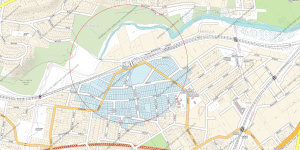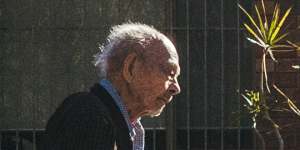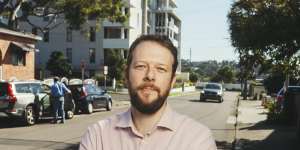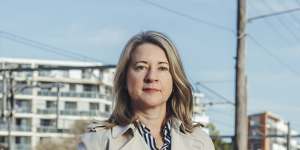Walk to the right,and you’ll be greeted by what makes up the tiny southern Sydney suburb of Turrella:471 houses,four unit blocks,a small convenience store and the Hot Grind Cafe,the only place selling coffee within a 15-minute walk.
There’s not a lot to do,but there aren’t too many people to complain about it:Turrella station records just 890 Opal tap-offs on an average day (nearby Wolli Creek records 7850),despite being just 17 minutes from Central.
But if the Minns government’s transit-oriented developed (TOD) policy is as effective as promised,that could soon change. Turrella was one of the 37 sites officially rezoned by the state government this month,and every home within 400 metres of the suburb’s train station can now be developed into a six-storey block of flats (pending all regular approvals by Bayside Council). Increasing supply,the government says,is part of solving the housing crisis.

Homes in Turrella,in Sydney’s south,have been upzoned by the state government.NSW Planning Portal
Unlike many other suburbs affected by the TOD program,Turrella’s geography – hills on one side,a creek on the other,with the station splitting the suburb in two unequal halves – will make creating a denser suburb with more amenities challenging.
And it highlights some of the issues caused when zoning is determined by drawing a circle on a map.
From chickens to flats with not much
Turrella – from an Indigenous word meaning “reedy place” or “water reeds” – was used for rural farming until the 1930s,when land was subdivided for industry and housing. A wave of post-war migrants soon moved in (people from Lebanon,many of whom moved to Australia after the 1940s,make up 15 per cent of Turrella’s population).
“When I came here,this was an industrial area,” said Maria,a Greek resident who has lived in Turrella for 27 years and did not give her surname. “We had chickens walking up and down the street. It was beautiful … And then they put all these flats up.”

Turrella is filled with mostly single-storey homes.Dion Georgopoulos
Those flats,built a decade ago,replaced an old drink production facility and stand on what was formerly the Streets ice-cream factory. They brought more people into the suburb that,until then,had been filled with mostly single-storey homes.
But those flats weren’t enough,and the suburb needs more of them,says Ronny Jaman,who with his wife Shila Ahmeda runs the Hot Grind Cafe that sits in a sliver of a unit complex that is publicly accessible.
The couple have run the business for nine months,and are a hit with the customers.
“I’m very much connected to everyone. I know everyone personally,they’re all my friends,” he says as another regular walks in,recounting the name of the customer’s dog and the circumstances of his life.
But Jaman wishes he could do that with more people. He says there aren’t enough people living around his cafe to sustain his business – or any business,really.
“Turrella should have a bank,or at least an ATM. Where is the ATM in Turrella? … If you’re an accountant,you need an office. You think these people don’t need accountants here?

Owners of the Hot Grind Cafe,Ronny Jaman and Shila Ahmeda.Dion Georgopoulos
“Rezoning is a good idea.[We are] close to the station,we should rock and roll.”
He suggests installing shops on the ground floors of apartments when more are built.
Eamon Waterford,the chief executive of the think tank Committee for Sydney,bought a home in the suburb with his wife just before COVID.
And it turned out to be perfect for that moment of life,he reflects:having a backyard for the couple’s two young children to play in when the city was locked down was a blessing.
But he has also noticed a “real lack of community” compared with the couple’s time living in apartments,and – this is the chief complaint – if he wants to goanywhere,he has to drive.
“You can’t walk to any of your daily needs in Turrella. I have to get in the car to do anything. I want to go to the shops,it’s in the car. I want to go to the park,it’s in the car. I want to meet up with friends,it’s in the car. I want to go to a cafe for breakfast,occasionally it’s here,” he says with a coffee from the Hot Grind,“but it’s generally in the car”.
The couple came to Turrella for the price,but like the hundreds who have brought in the suburb after being priced out of the inner west,if more amenities don’t come to Turrella,his family will pack up.

Eamon Waterford,chief executive of the Committee for Sydney,is a Turrella resident and says the suburb desperately needs more amenities.Dion Georgopoulos
The situation in Turrella could not be more different from that of Wolli Creek,the next suburb along,just a two-minute train ride away. Also a former industrial precinct,the suburb is now among the densest in Sydney – and it also comes with three supermarkets and at least 20 restaurants and cafes.
“My initial impression of Wolli Creek before I lived here was not good,” Waterford says. “[I thought] it was stale,sterile,overdeveloped … just a dormitory suburb.
“What I’ve realised now that I live here and actually spend time in Wolli Creek in the evenings,is that it’s really thriving.
“And interestingly,the parts of Wolli Creek that feel the nicest to spend time in are those that are a little bit lower density. They have that level of airiness,there’s a lot of trees,they feel more human-scaled.
“And I think that’s what makes this TOD program so sensible. Because it does hit that European style Parisian density that is still really high density,in that you get a lot of people into a small amount of space,but it doesn’t feel overwhelming.”
Old warehouses next to prime train station

Erika Pawley,the director of Leamac Property Group.Dion Georgopoulos
If the residential side of Turrella is lacking in amenities,the industrial side is a ghost town. Paintball facilities,benchtop companies and a bus depot make up the few warehouses on the land sitting between the train station and Wolli Creek.
“It’s not loved. You don’t come out here and think,this is a really high-functioning area,” says Erika Pawley – an urban planner with 25 years’ experience in government planning,now a director at Leamac Property Group – as she walks down the street with theHeraldon a cloudy Friday afternoon.
“There’s been a failure of urban systems … There are huge trucks coming into this relatively constrained area. And you’ll see everywhere,signs that have been knocked over,crash barriers that are getting bumped into,kerbs that are smashed up with large trucks coming in and out.”

Leamac had previously attempted to make the creek accessible to the public by redeveloping several warehouses into a mixed-use precinct,with paths around the creek.
“Our concept was to still have quite a good amount of employment in the precinct – in fact,potentially more jobs than what is there now – but jobs that are more compatible with residential,jobs that don’t necessarily rely on big heavy trucks.”
But the state’s “retain and manage” approach to industrial land – that because of a severe lack of it in Sydney – meant it couldn’t be rezoned for housing.

The Department of Planning,Housing and Infrastructure is currently reviewing the “retain and manage” policy,but has not yet decided on its future.
“Industrial land on one side of the station supports jobs in the manufacturing,engineering and transportation sectors,and is a key feature of the current community,” Planning Minister Paul Scully said in a statement.
“Turrella was identified as a Transport Oriented Development site as it has the capacity to create more homes,in well-located places,near well-connected transport infrastructure and jobs,” he said.
“DAs can now be submitted in Turrella which could include mixed use residential and commercial developments which will add vibrancy and new activity to the community.”
Scully also pointed to the state government’s recent announcement of a 4.5 hectare (11-acre) expansion of the Wolli Creek Regional Park – the state’s only regional park in an urban environment – that will support increased density in the area.

Bayside Council is largely supportive of the increased housing,its mayor Bill Saravinovski said last month. “However,it is important that new housing is delivered in a way that creates a good quality of life for new residents and builds great communities,” he said.
In a local Facebook group set up to “save” the area,some residents have reported being approached by developers to sell their properties.
Waterford hasn’t yet. But would he?
“Yeah,I probably would. It’s always:is the price something your neighbours are interested in? Because ultimately,no one’s going to buy a single house and redevelop it. They’ll buy a block of houses.
“The alternative is you don’t sell but you get to live in a higher density community,and all the increased amenity that comes along with that. So I’m kind of agnostic to the question of whether we sell or not,but I can confidently say if nothing was to happen here,we’d probably move on.”
Start the day with a summary of the day’s most important and interesting stories,analysis and insights..